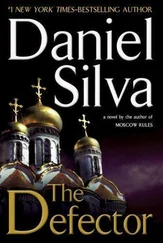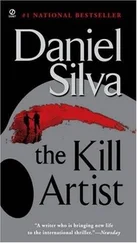1 ...6 7 8 10 11 12 ...23 For the moment, Saladin was a French problem. But the fact that four Israeli citizens had perished in the attack gave Navot standing in Paris. So, too, did the name that Clovis Mansour had whispered into Mikhail’s ear in Beirut. In fact, with a bit of skilled salesmanship, the name alone might be enough to secure the Office a seat at the operational table. Navot was confident in his powers of persuasion. A former field agent and recruiter of spies, he had the ability to spin straw into gold. All he needed was someone to look after the Office’s interest in any joint Franco-Israeli undertaking. He had but one candidate in mind, a legendary field agent who had been running operations on French soil since he was a boy of twenty-two. What’s more, the operative in question had known Hannah Weinberg personally. Unfortunately, the prime minister had other plans for him.
Navot checked the time; it was ten fifteen. He reached for his phone and dialed Travel.
“I need to fly to Paris tomorrow morning.”
“The six o’clock or the nine?”
“The six,” said Navot despondently.
“When are you coming back?”
“Tomorrow night.”
“Done.”
Navot rang off and then placed a final call. The question he posed was one he had asked many times before.
“How long before he’s finished?”
“He’s close.”
“How close?”
“Maybe tonight, tomorrow at the latest.”
Navot replaced the receiver and allowed his gaze to wander the spacious office that soon would no longer be his.
Tomorrow at the latest …
Maybe, he thought, or maybe not.
5
ISRAEL MUSEUM, JERUSALEM
IN THE FAR CORNER OF the conservation lab, a black curtain stretched from the white ceiling to the white floor. Behind it was a matching pair of oaken Italian easels, two halogen lamps, a Nikon camera mounted atop a tripod, a palette, a tiny bale of cotton wool, an ancient CD player smudged with several different colors of paint, and a trolley laden with pigments, medium, solvents, wooden dowels, and several Winsor & Newton Series 7 sable-hair paintbrushes. For the better part of the past four months, the restorer had labored there alone, sometimes late at night, sometimes long before dawn. He wore no museum credentials, for his true place of employment was elsewhere. The staff conservators had been advised not to mention his presence or even to speak his name. Nor were they to discuss the large painting, an Italian Old Master altarpiece, propped upon his easels. The painting, like the restorer, had a dangerous and tragic past.
He was below average in height—five foot eight, perhaps, no more—and slender of build. His face was high at the forehead and narrow at the chin, with wide prominent cheekbones and a long, bony nose that looked as though it had been carved from wood. The dark hair was cropped short and stained with gray at the temples, the eyes were an unnatural shade of green. His age was one of the most closely guarded secrets in Israel. Not long ago, when his obituary appeared in newspapers around the world, no verifiable date of birth ever found its way into print. The reports of his death had been part of an elaborate operation to deceive his enemies in Moscow and Tehran. They had believed the stories to be true, a miscalculation that allowed the restorer to take vengeance against them. Not long after his return to Jerusalem, his wife gave birth to a set of twins, a girl named Irene after his mother, and a son called Raphael. They were now—mother, daughter, son—three of the most closely guarded people in the State of Israel. So, too, was the restorer. He came and went in an armored American-made SUV, accompanied by a bodyguard, a fawn-eyed killer of twenty-five, who sat outside the door of the conservation lab whenever he was present.
His appearance at the museum, on a black and wet Wednesday in December a few days after the birth of his children, had come as a shock, and a profound relief, to the rest of the conservation staff. They had been warned he did not like to be observed while working. Still, they routinely poked their heads into his little curtained grotto merely to glimpse the altarpiece with their own eyes. Truth be told, he couldn’t blame them. The painting, Caravaggio’s Nativity with St. Francis and St. Lawrence , was arguably the world’s most famous missing work of art. Stolen from the Oratorio di San Lorenzo in Palermo in October 1969, it was now formally in the possession of the Vatican. The Holy See had wisely decided to withhold news of the painting’s recovery until the restoration was complete. Like many Vatican pronouncements, the official version of events would bear little resemblance to the truth. It would not mention the fact that a legendary Israeli intelligence officer named Gabriel Allon had found the missing painting hanging in a church in the northern Italian town of Brienno. Nor would it mention that the same legendary intelligence officer had been entrusted with the task of restoring it.
During his long career he had carried out several unusual restorations—he had once repaired a Rembrandt portrait that had been pierced by a bullet—but the Caravaggio altarpiece propped upon Gabriel’s easels was without question the most damaged canvas he had ever seen. Little was known of its long journey from the Oratorio di San Lorenzo to the church where he had found it. The stories, however, were legion. It had been kept by a Mafia don as a prize and brought out for important meetings of his henchmen. It had been chewed by rats, damaged in a flood, and burned in a fire. Gabriel was certain of only one thing: the painting’s wounds, while grievous, were not fatal. But Ephraim Cohen, the museum’s chief of conservation, was dubious. Upon seeing the painting for the first time, he advised Gabriel to administer last rites and return the altarpiece to the Vatican in the same wooden coffin in which it had arrived.
“Ye of little faith,” Gabriel had said.
“No,” replied Cohen. “Me of limited talent.”
Cohen, like the other members of the staff, had heard the stories—the stories of deadlines missed, of commissions abandoned, of church reopenings delayed. The snail-like pace of Gabriel’s work habits was legendary, almost as legendary as his exploits on the secret battlefields of Europe and the Middle East. But they soon discovered that his slowness was voluntary rather than instinctive. The craft of restoration, he explained to Cohen one evening while swiftly repairing the tattered face of Saint Francis, was a bit like making love. It was best done slowly and with painstaking attention to detail, with occasional breaks for rest and refreshment. But in a pinch, if the craftsman and his subject matter were adequately acquainted, a restoration could be done at extraordinary speed, with more or less the same result.
“You and Caravaggio are old friends?” asked Cohen.
“We’ve collaborated in the past.”
“So the rumors are true then?”
Gabriel had been painting with his right hand. Now he moved the brush to his left and worked with equal dexterity.
“What rumors are those?” he asked after a moment.
“That you were the one who restored the Deposition for the Vatican Museums a few years ago.”
“You should never listen to rumors, Ephraim, especially when they concern me.”
“Or the news,” said Cohen darkly.
His hours were erratic and unpredictable. An entire day might pass with no sign of him. Then Cohen would arrive at the museum to find a large portion of the canvas miraculously restored. Surely, he thought, he had a secret helper. Or perhaps Caravaggio himself was stealing into the museum at night, a sword in one hand, a brush in the other, to assist with the work. After one nocturnal session—a particularly productive visit during which the Virgin was returned to her former glory—Cohen actually checked the security footage. He found that Gabriel had entered the lab at half past ten in the evening and had departed at seven twenty the next morning. Not even the fawn-eyed bodyguard had been with him. Perhaps it was true, thought Cohen, as he watched the ghostly figure moving at one frame per second along a half-lit hall. Perhaps he was an archangel after all.
Читать дальше












